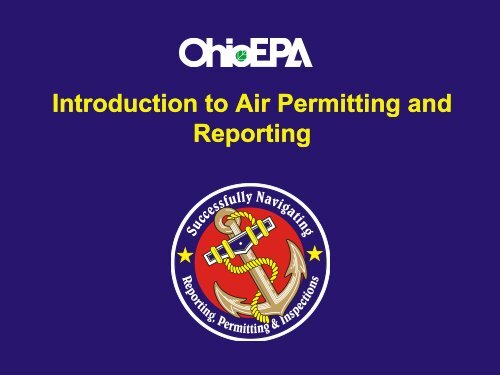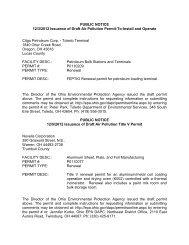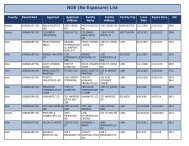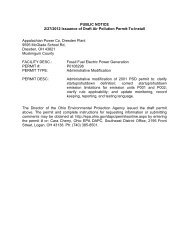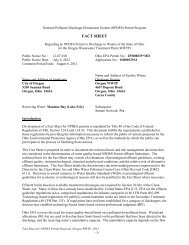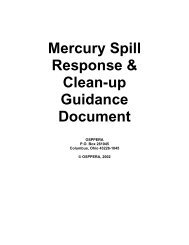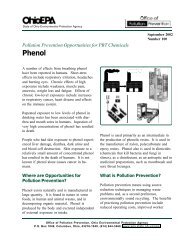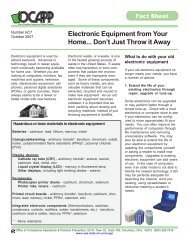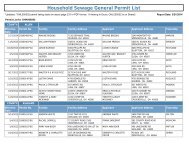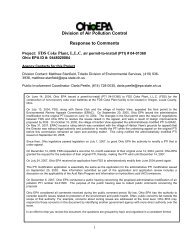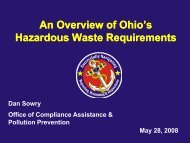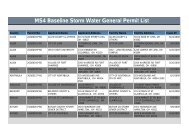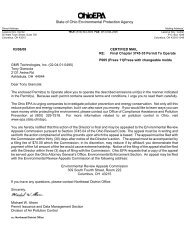Introduction to Air Permitting and Introduction to Air ... - Ohio EPA
Introduction to Air Permitting and Introduction to Air ... - Ohio EPA
Introduction to Air Permitting and Introduction to Air ... - Ohio EPA
Create successful ePaper yourself
Turn your PDF publications into a flip-book with our unique Google optimized e-Paper software.
<strong>Introduction</strong> <strong>to</strong> <strong>Air</strong> <strong>Permitting</strong> <strong>and</strong>Reporting
Overview of SessionPart 1 What operations need air permits, what is exempt Types of permits The permit application process Permit recordkeeping <strong>and</strong> reporting QuestionsBreak
Overview of SessionPart 2 Recent changes <strong>to</strong> permitting process Allowed construction <strong>Air</strong> <strong>to</strong>xics <strong>and</strong> BAT PTIO Preview of <strong>Air</strong> Services system Questions
<strong>Air</strong> <strong>Permitting</strong> BasicsRick CarleskiOffice of Compliance Assistance<strong>and</strong> Pollution Prevention(614) 728-1742
Basic facts (continued) <strong>Air</strong> permits are for specific equipment at thatfacility location. New permit is needed if equipment is moved <strong>to</strong>new address. Moving it within the building isgenerally OK. Permits can be transferred <strong>to</strong> a new owner.
Why Permits Are Important:Focus of <strong>EPA</strong> Inspections Inspec<strong>to</strong>r will check if company is maintainingrecords required by air permits. Inspec<strong>to</strong>r will check <strong>to</strong> see if everything thatneeds an air permit has one.
Common <strong>Air</strong> Quality Violations Installing <strong>and</strong> operating equipment withou<strong>to</strong>btaining proper permits. Not maintaining records required by permits. Exceeding permit limits. Not maintaining air pollution controlequipment.
What Needs an <strong>Air</strong> Permit? No definitive list exists! Permit needed d for “air pollution source,” “aircontaminant source” or “emission unit” ” = eachseparate activity or operation that emits airpollutants.t Permit is only for that air pollution source.Company may need several air permits <strong>to</strong> coverall plant operations.
What May Need an <strong>Air</strong> Permit?4 Rules of Thumb: Something with a stack, vent or dust collec<strong>to</strong>r. Something that uses solvents, paints, inks oradhesives. Something that burns fuel. Something that causes smoke, dust or odors.
Common things needingpermitsBoilerPaint boothPrinting pressDry cleanerS<strong>to</strong>ne crushing
Does Everything Needan <strong>Air</strong> Permit?NO – three options for exemption:1. Permanent exemptions (OAC 3745-31-03) Lists 45+ types of equipment <strong>and</strong> processesthat do not need air permits. No <strong>EPA</strong> notification required.
Some things exempt underpermanent exemptions…Boilers, water heaters< 10 million Btu/hrLab fume hoodsS<strong>to</strong>rage tanksS<strong>to</strong>rage tanks
More examples….Small solventparts washersNon-vented machining operationsSolvent reclaiming unitsSolvent reclaiming units< 20 gallon capacity
<strong>Air</strong> permit exemptions (cont.)2. Permit-by-rule exemption OAC 3745-31-03(A)(4)• Emergency genera<strong>to</strong>rs• Plastic parts molding• Small crushers• Ground water/soilcleanup• Au<strong>to</strong> body shops• Gas stations• Gas-fired boilers• Printing shopsSimple 1-page notification <strong>to</strong> <strong>Ohio</strong> <strong>EPA</strong> required
<strong>Air</strong> permit exemptions (cont.)3. “DeDe minimis” source exemption(OAC 3745-15-05)Emits less than 10 lbs/day of air pollutants <strong>and</strong>;Less than 2000 lbs/yr of hazardous airpollutants.Can’t be subject <strong>to</strong> federal rules.Requires emission calculations.
<strong>Air</strong> Permit Self-Assessment1. Tour your plant <strong>to</strong> identify all air pollutionsources using the 4 rules of thumb.2. Determine what operations fit the permanentexemptions or permit-by-rule.3. Determine if remaining operations can bede minimis by doing emission calculations.4. Assume remaining sources need a permit.
Types of <strong>Air</strong> PermitsPermit <strong>to</strong> Install (PTI) One-time permit needed before installingequipment. For equipment installed after January 1, 1974,can be done years after installation. 1-6 month processing time. One-time fee. Allows 18 months <strong>to</strong> start construction.
Types of <strong>Air</strong> Permits (cont.)Permit <strong>to</strong> Operate (PTO)* Allows continued operation after PTI. 5-year term, renewable. “Title V permit” = one big PTO for whole facility.* Phased out after July 2008
New Type of <strong>Air</strong> PermitPermit <strong>to</strong> Install <strong>and</strong> Operate (PTIO) Covers both installation ti <strong>and</strong> operation. For smaller, non-Title V facilities. 5-10 year term, renewable. Consolidates requirements.Coming July 2008!
Permit Application Form Data Company name, address. Detailed description & diagram of equipmentbeing installed/operated. Usage rates of raw materials, fuels. Production rates of finished products. Description of pollution controls. Estimate of types & quantities of emissions.
Permit Process Company completes PTI application. Submits <strong>to</strong> District <strong>Ohio</strong> <strong>EPA</strong> office. District Office reviews for completeness within 14days, notifies company. District does technical review, writes permit,sends <strong>to</strong> Central Office (Columbus). 1-3 months.
Permit Process (cont.) Central Office performs review, < 1 month; returns<strong>to</strong> district if needed. Central Office issues permit either:Final – usually within 2-4 weeksDraft – published in local paper, 30-daypublic comment, adds 45+ days minbefore final is issued.
Permit Processing Pitfalls Incomplete application (unsigned, wrong form,missing data, no process diagram). Submitting application at last minute beforestarting construction. Not anticipating public concern, possible draftpermit adding time.
Tips for Faster PermitsGeneral Permit option “Canned permit,” can view beforeh<strong>and</strong> 45 day or less processing time Simplified application form<strong>Ohio</strong> <strong>EPA</strong> “Rush List” Written demonstration of economic or financialhardship.ads
Tips for Faster Permits (cont.) Make sure application is complete. Meet with district office <strong>to</strong> discuss installationbefore submitting application. Stay in contact with district permit engineer. Promptly respond <strong>to</strong> requests for additionalinformation.
Tracking Your Permit1. Contact your local district office2. Online through DAPC’s Web site:www.epa.state.oh.us/dapc/pti/ptimain.html
<strong>Air</strong> Permit Summary & ReportingAdam WardDivision of <strong>Air</strong> Pollution Control,Central District Office(614) 728-3778
Permits <strong>and</strong> Reporting Permit Structure Reporting Types Fee Reports Helpful Hints
Permit Structure General terms <strong>and</strong> conditions Facility specific requirements Emissions i Unit specific requirementsA. Summary Table• Emission unit description• Applicable rules• Emission limits
Permit StructureB. Operational restrictionsC. Moni<strong>to</strong>ring <strong>and</strong>/or record keepingrequirementsD. Reporting requirementsE. Testing requirementsF. Miscellaneous requirements
PART II - SPECIAL TERMS AND CONDITIONS FOR SPECIFIC EMISSIONS UNIT(S)A. Applicable Emissions Limitations <strong>and</strong>/or Control Requirements2. The secondary combustion chamber temperature shall be maintained at 1600degrees Fahrenheit or greater during each cremation cycle.3. The stack shall be designed <strong>to</strong> minimize any building down wash impacts from1. The specific operations(s), property, <strong>and</strong>/or equipment which constitute thisemissions unit are listed in the following table along with the applicable rules<strong>and</strong>/or requirements <strong>and</strong> with the applicable emissions limitations <strong>and</strong>/or controlemissions <strong>and</strong>/or odors on employees <strong>and</strong> nearby residences. The design shallmeet good engineering practices so as not <strong>to</strong> result in excessive concentrations ofair contaminants <strong>and</strong>/or odors in locations at, near or, in such a configuration, asmeasures. Emissions from this unit shall not exceed the listed limitations, <strong>and</strong> the<strong>to</strong> affect any air intake for heating <strong>and</strong> cooling of buildings or at operablelisted control measures shall be specified in narrative form following the table.windows or doors.Operations, Property,<strong>and</strong>/or EquipmentN002 - Animal Crema<strong>to</strong>ry,ISI-1600, 200 pounds ofwaste per hour with anafterburnerApplicable Rules/RequirementsOAC rule 3745-31-05(A)(3)Applicable EmissioLimitations/Control MParticulate emissions (PE) sha0.20 pound per hour <strong>and</strong> 0.88Visible PE from the afterburnenot exceed 5% opacity, as a 6-average.The requirements of this rule acompliance with the requiremerule 3745-17-09(B)&(C).C. Moni<strong>to</strong>ring <strong>and</strong>/or Recordkeeping Requirements1. The permittee shall operate <strong>and</strong> maintain a continuous temperature moni<strong>to</strong>r whichmeasures the secondary combustion chamber temperature, in degrees Fahrenheit.The moni<strong>to</strong>r shall be installed, calibrated, operated <strong>and</strong> maintained in accordancewith the manufacturer's recommendations.D. Reporting Requirements1. The permittee shall submit deviation (excursion) reports within 30 days of whenthe deviations occur, which provide the following information for each periodduring which the secondary combustion chamber exhaust gas temperature fellbelow the applicable limitations:OAC rule 3745-15-07OAC rule 3745-17-09(B)&(C)2. Additional Terms <strong>and</strong> ConditionsSee section A.2.a below.See section B.3 below.PE shall not exceed 0.10 pounpounds of material charged. Sebelow.2.a The hourly <strong>and</strong> annual criteria pollutant emission limitations wereestablished for PTI purposes <strong>to</strong> reflect the potential <strong>to</strong> emit for thisemissions unit. Therefore, only the moni<strong>to</strong>ring, record keeping <strong>and</strong>/orreporting requirements of the afterburner are necessary <strong>to</strong> ensurecompliance with these emission limitations.B. Operational Restrictions1. All material shall be incinerated in a controlled air, multi-chamber incinera<strong>to</strong>r, orequivalent technology as approved by the Direc<strong>to</strong>r, which provides completea. the date of the excursion;b. the time interval over which hthe excursion occurred;c. the temperature values during the excursion;E. Testing Requirements1. Compliance with the emission limitations in Section A.1. of these terms <strong>and</strong>conditions shall be determined in accordance with the following methods:a. Emission i Limitation:it tiPE shall not exceed 0.20 pound per hour.F. Miscellaneous RequirementsNoneApplicable Compliance Method:This limit is based on the maximum rated capacity of the emissions unit(200 pounds of waste per hour) multiplied by the allowable emission limi<strong>to</strong>f 0.10 pound particulate/100 pounds charged.Environmental <strong>Permitting</strong> In <strong>Ohio</strong> - July 28, 200418
Recordkeeping Emissions unit specific or rule based Designed <strong>to</strong> ensure equipment operates properly Emissions tracking used <strong>to</strong> demonstrate ongoingcompliance
Why Have Reporting Requirements? Method of notifying regula<strong>to</strong>ry authorities of thefollowing: equipment malfunctions (un)scheduled maintenance emission i releases failure <strong>to</strong> follow permit requirements Fee reports
What Requires Opera<strong>to</strong>r <strong>to</strong> Submit a Permits: quarterly, annual, other Rules:Report? immediately, within 30 days, within 45 days Federal rules: quarterly, annual, other Emergency Response
Where are Reporting RequirementsFound? Issued permit (PTI, PTIO, PTO, Title V): general terms <strong>and</strong> conditions (T&C)s emission unit specific T&Cs Rules: OAC rules 3745-21-09, 3745-15-06, etc. federal rules MACT, NSPS, etc.
Permit ReportsQuarterly Deviations include departures fromthe following: emission limits operational restrictions control device operating parameters
Permit ReportsInclude for each quarterly deviation: probable cause(s) any corrective actions or preventativemeasures
Permit ReportsNegative declaration reports are needed.d“If no deviations occurred during a calendar quarter, thepermittee shall submit a quarterly report, which states thatno deviations occurred during that quarter...” In other words, facilities must submit a report each <strong>and</strong>every quarter, regardless of whether or not deviationsoccurred
Rule Based Reports Found in issued air permits Reporting frequency will be specified Examples: within ihi 30d days, within ihi 45ddays, etc. See h<strong>and</strong>out
Permit ReportsSynthetic minor facilities may have additionalreporting annual emissions annual production other unique reports
Malfunctions Breakdown of control equipment that results in aviolation (i.e., fabric filter, incinera<strong>to</strong>r, carbonadsorber, etc.) Scheduled/unscheduled maintenance <strong>to</strong> avoid amalfunction Report malfunction immediately
OAC 3745-1515-06(B):Malfunctions Notify <strong>Ohio</strong> <strong>EPA</strong> or Local <strong>Air</strong> Authority Written report within 2 weeks if longer than 72hours If reported properly, then not included in quarterlydeviation report
Malfunction Report Information Identification of <strong>and</strong> location of source Duration of breakdown Quantity of release Statement saying why shutdown of EU was not possible breakdown time is reasonable interim control measures used used PM&MA plan, if applicable
Fee Feports Actual emissions determine fee Different for Minor facilities <strong>and</strong> SyntheticMinor facilities All fee reports are mailed in February <strong>and</strong>due April 15 (2008 extended until June 6) Invoice sent later by <strong>Ohio</strong> <strong>EPA</strong>
Blue Sheets Permittee reports emissions <strong>Ohio</strong> <strong>EPA</strong> confirms <strong>and</strong> calculates fee Invoice based upon the amount reported
Blue Sheets 2 year reporting cycle (2004, 2006, 2008...) Annual fees are: 0-9 <strong>to</strong>ns = $100.00 10-49 <strong>to</strong>ns = $200.00 50-99 <strong>to</strong>ns = $300.00 100 or more = $700.00
Synthetic Minor Fee Reports Permittee reports emissions <strong>Ohio</strong> <strong>EPA</strong> confirms <strong>and</strong> calculates fee Invoice based upon the amount reported
Synthetic Minor Fee Reports Emissions are calculated on an emissionsunit basis Annual reporting cycle Annual fee ranges from $170.00 00 <strong>to</strong>$3,350.00
Helpful Hints <strong>Ohio</strong> <strong>EPA</strong> goal is compliance, NOT enforcement Know your <strong>Ohio</strong> <strong>EPA</strong> contact Applications: complete forms <strong>to</strong> allow for maximum operationalflexibility fill out the forms <strong>to</strong> the best of your ability ask questions communicate urgency
Helpful Hints Make recordkeeping as simple as possible Develop a pattern for recordkeeping <strong>and</strong> reportsubmittals Foster a good relationship with neighbors
BreakBe back in 15 minutes….
<strong>Air</strong> Program Changes <strong>and</strong> UpdatesAdam Ward &Jennifer HunterDivision of <strong>Air</strong> Pollution Control<strong>Ohio</strong> <strong>EPA</strong>
S.B. 265 Changes <strong>to</strong><strong>Air</strong> Permit Program1. Construction prior <strong>to</strong> a PTI or PTIO.2. <strong>Air</strong> <strong>to</strong>xic emissions updates.3. Best Available Technology (BAT) changes.4. Permit-<strong>to</strong>-Install <strong>and</strong> Operate (PTIO)5. Permit Evaluation Report (PER)6. <strong>Air</strong> Services
Construction ActivitiesCurrent rules allow the following... Clear site (vegetation, buildings, equipment); Grading <strong>and</strong> site prep for foundations; Excavating footers, pilings, foundations, pads, <strong>and</strong>platforms, etc. Concrete forms <strong>and</strong> re-bar (no pouring!!) L<strong>and</strong>scaping Utility poles by a utility company.
Construction ActivitiesCurrent rules also allowed the following... Temporary site access roads/parking; equipments<strong>to</strong>rage areas; Temporary utilities for construction activities; Temporary construction dust control systems(sprinklers, etc.); Temporary erosion <strong>and</strong> sedimentation control (haybales, silt fences, rip-raps, raps, s<strong>and</strong>bags).
Construction ActivitiesSince Dec. 1, 2006, OAC 3745-31-3333 specifies: No changes for “MAJOR” sources.(No newly approved construction activities apply.) New provisions for “MINOR”* sources.(Additional activities allowed.)*minor here does not apply <strong>to</strong> a: major modification, major stationary source, syntheticminor, or netting project
Construction ActivitiesConstruction activities now approved for “minor”sources allow almost everything except utilities hook-up <strong>and</strong> operation. For any air contaminant source/control equipment, you caninstall:► Electrical up <strong>to</strong> the service panel;► Piping <strong>and</strong> sewers up <strong>to</strong> the point of connection; <strong>and</strong>► Inlet air <strong>and</strong> exhaust duct work with the exception of finalconnections. Site drainage systems for underground s<strong>to</strong>rm drains,headwalls <strong>and</strong> catch basins (must obtain necessary s<strong>to</strong>rmwater permits first).
Construction ActivitiesAdditional activities for “minor” sources… Equipment that is a component of an air contaminantsource/control may be delivered <strong>to</strong> the site prior <strong>to</strong> PTIissuance if:►It is <strong>to</strong> be installed in an existing building, then it may beplaced in its final location <strong>and</strong> secured.►If it is <strong>to</strong> be installed in a building that has not yet beenbuilt, then it can either be secured on the foundation ofits final site or placed anywhere on the property.Reminder: No utilities, piping, or duct work may be connected<strong>and</strong> equipment cannot be operated.
<strong>Ohio</strong>’s <strong>Air</strong> Toxics PolicyIn the past…. <strong>Ohio</strong>’s <strong>Air</strong> Toxics Policy - Review any of the 700+compounds in the ACGIH book.Effective Dec. 1, 2006 [OAC 3745-114-01]… 303 <strong>to</strong>xic compounds.
<strong>Ohio</strong>’s <strong>Air</strong> Toxics PolicyImplemented in accordance with OAC 3745-114114-01<strong>and</strong> ORC 3704.03 (F)(4)(a) Must use “Option A” (same as before). Applicant provides <strong>to</strong>xic information o in application. Emission limits <strong>and</strong> restrictions are needed inPTI/PTIOs under specific circumstances.
<strong>Ohio</strong>’s <strong>Air</strong> Toxics PolicySources exempt empt from these requirements: If MACT, BACT, LAERfor that air contaminantis applicable Parking lots S<strong>to</strong>rage piles S<strong>to</strong>rage tanks Transfer operations Grain silos & dryers Emergency genera<strong>to</strong>rs Gasoline dispensingoperations Emissions i solely l fromthe combustion of fossilfuels Emission of wood dust,s<strong>and</strong>, glass dust, coaldust, silica, <strong>and</strong> graindust.
<strong>Ohio</strong>’s <strong>Air</strong> Toxics Policy >1 <strong>to</strong>n per year allowed under permit
<strong>Ohio</strong>’s <strong>Air</strong> Toxics Policy Step 1: Is source exempt? Step 2: Will source emit a regulated aircontaminant >1 <strong>to</strong>n/year? Step 3: Review Option A <strong>and</strong> Eng Guide 69 Step 4: Run the model or contact DO/LAA forassistance
Background PTI content based on two principals:i I. Requirements from rulesII.BAT analysis (case-byby-case)►Usually an emission limitation►Analysis of similar sources►Consistent BAT requirement developed
Changes <strong>to</strong> BATEffective Aug. 3, 2006 [ORC 3704.03 (T)] ….
Changes <strong>to</strong> BAT Development of BAT rules are just beginning Watch for upcoming changes on website:What’s New: http://www.epa.state.oh.us/dapc/page/whatsnew.htmlRegulations:http://www.epa.state.oh.us/dapc/regs/regs.html Get on our Interested Party List http://www.epa.state.oh.us/rules.html
Latest Changes <strong>to</strong> <strong>Air</strong> <strong>Permitting</strong>Jennifer HunterDivision of <strong>Air</strong> Pollution Control(614) 644-3696
Current Frustrations Need <strong>to</strong> modify both PTI <strong>and</strong> PTO Where is my permit? Quarterly, semi-annual or annual reports? Different renewal dates for each unit Paper, Paper, Paper!!!!
PTIO: What? Permit <strong>to</strong> Install <strong>and</strong> Operate (PTIO) allows installation <strong>and</strong> operation minor <strong>and</strong> Synthetic Minor facilities one application simple modifications PTIO will replace all previous PTI <strong>and</strong> PTO permits foran emissions unit over time quarterly reporting <strong>to</strong> annual grouped permit terms for identical units
PTIO: What? Entire facility renews on same date all PTIOs expire on the same date renewal applications will be due <strong>to</strong>gether 10 yr renewal for minor sources 5 yr renewal for Synthetic Minor sources
PER Permit Evaluation Report (PER) annual report for deviations will replace most quarterly reports covers all units issued a PTIO Does not replace rule-based reporting
O<strong>EPA</strong> will mail:PER reminder <strong>and</strong> PER form only units that have been issued a PTIO Will ask for specific information Due date is one of 4 days during year
PER-Page Page 1 Basic facilityinformationpre-populatedpopulated Identify ifchangesneeded in boxbelow
PER-Page Page 2 Emissions Unit(s)table pre-populated Box <strong>to</strong> identifyany additionalinfo/corrections Responsibilitylanguage
PER-Page Page 3+ Complete a detailedemissions unit formfor each emissionsunit with a PTIO Instructions at <strong>to</strong>p ofform Fields in [brackets]are pre-populatedpopulated
PER-Page Page 3+ Complete adetailed emissionsunit form for eachemissions unit witha PTIO Fields in [brackets]are pre-populatedpopulated
PER-Deviations or Exceedances Answer “YES” or “NO” If “YES” , attach information identified ininstructions:►Dates, duration, probable cause, correctiveaction information
<strong>Air</strong> Services: What? New optional web-based based system forapplications, reporting <strong>and</strong> more!Log-in <strong>to</strong> your facilityComplete application, report, etc.Click Submit= instant electronic submittalNo paper printing, no paper signature, nomailing!
<strong>Air</strong> Services: How? Go <strong>to</strong> eBusiness CenterStep 1: Create accountStep 2: Request a PIN►Complete simple online form►print out►take <strong>to</strong> notary with ID►send <strong>to</strong> <strong>Ohio</strong> <strong>EPA</strong>►you y get a PIN number back = your signatureStep 3 – request access <strong>to</strong> <strong>Air</strong> Services <strong>and</strong> yourfacility►simple i l online request
<strong>Air</strong> Services: How?PIN gives you access <strong>to</strong> your facility information►Only person responsible for facility needs aPIN►Person with PIN can give other accountholders (Step 1) permission <strong>to</strong> preparedocuments, but not submit, OR►Person with PIN can give other accountholders with PIN (Steps 1 <strong>and</strong> 2) permissions<strong>to</strong> prepare <strong>and</strong> submit
<strong>Air</strong> Services: How?Generate <strong>and</strong> submit:What can you do?applications: PTIO, permit-by-rule, generalpermits, admin modifications, corrections <strong>to</strong>applications.reports: fee emissions, PER <strong>and</strong> ALL others youmay have.Changes <strong>to</strong> owners/contacts
View:<strong>Air</strong> Services: How?all your emissions unitsWhat can you do?previously submitted applicationspermitsphis<strong>to</strong>rical facility make-upprogress of your application at <strong>Ohio</strong> <strong>EPA</strong><strong>and</strong> much, much more!
<strong>Air</strong> Services: How? <strong>Ohio</strong> <strong>EPA</strong> migrates all existing electronic data in<strong>to</strong><strong>Air</strong> Services = Gives you a starting point !your emissions units, control equipment, egress points,etc.contacts, owners, opera<strong>to</strong>rshis<strong>to</strong>rical applicationshis<strong>to</strong>rical permit documentshis<strong>to</strong>rical fee reports
<strong>Air</strong> Services Home PageLook at your“Facility Profile= what O<strong>EPA</strong>seesaccesshis<strong>to</strong>ry & infostartapplications,reports, etc.
Facility Profile Pageaccesssummaryinfobasic facility info“Facility Tree”
Facility Tree ConceptRepresents the operations at your facilityWe start it for you (migrated data)You maintain it – add emissions units, etcUse it <strong>to</strong> do all your tasks – apply for permits, fee reports, etc.Facility ID = hyperlink <strong>to</strong> the Facility ProfileEmissions UnitProcess = SCCControl EquipmentEgress Point = stack or fugitiveClick on IDs <strong>to</strong> open pagewith specific information
Apply for Permits <strong>Air</strong> Services HomeNew Task – click “PTI/PTIO Application”Can copy from a previously submitted application–shortcut!Can copy information for similar emissions units –shortcut!Fill out application fields – same as the paperversionClick “Save”
Complete Compliance Reports <strong>Air</strong> Services HomeNew Task – click “Permit Evaluation Report (PER)”Fill out PER fields – same as the paper versionSome fields pre-populated populated for youClick k “Save”
Save, Validate <strong>and</strong> SubmitDocuments Save for as long as you want before submitting All “In progress tasks” (saved documents) are NOTviewable by <strong>Ohio</strong> <strong>EPA</strong> until you submit Click “Validate” – ensures minimum fields complete Submit <strong>and</strong> enter PIN INSTANT SUBMITTAL!!!No paper copies <strong>to</strong> print, sign <strong>and</strong> mail.
Cool StuffEMISSIONS UNITSTable of all emissions units at facilityClick l k on ID <strong>to</strong> view their information
Cool StuffEVENT LOGTrack progressof applications,permits,reports, etc.
Cool StuffAPPLICATION(S)Table of all applications submitted (even his<strong>to</strong>rical)Click on link <strong>to</strong> view them as submitted
Cool StuffPERMIT(S)Table of allpermitsissueddraft orfinal (evenhis<strong>to</strong>rical)Click onlink <strong>to</strong>view them
Cool StuffMore Summary Tables with links <strong>to</strong>:►Emissions Reports►Compliance Reports►Control Equipment►Egress PointsReferences Page with links <strong>to</strong>:►Guidance documents►EAC forms►Tools►More!!!ONLINE HELP!!!
<strong>Air</strong> Services <strong>and</strong> PTIO: When? Applications available in May 2008 <strong>Air</strong> Services available <strong>and</strong> PTIOs issued afterJune 30, 2008
<strong>Air</strong> Services <strong>and</strong> PTIO Information PTIO electronic news via email· e-mailmajordomo@lists.epa.state.oh.us· enter “subscribe PTIO” as the message PTIO info website:http://www.epa.state.oh.us/dapc/permits/ptio.html <strong>Air</strong> Services info website:http://www.epa.state.oh.us/dapc/airservices/
Questions?


